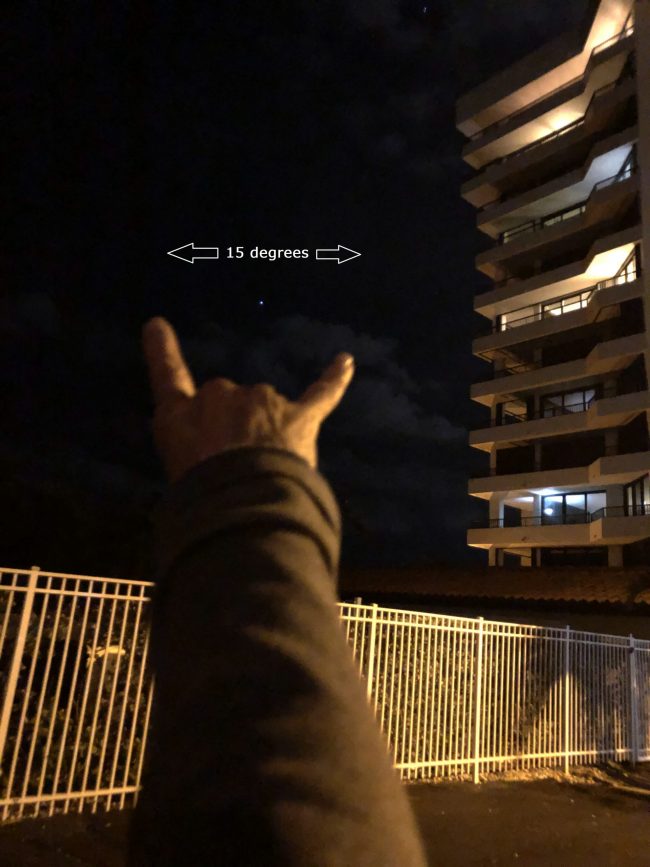
How do you describe how far apart something is in the sky? The fact is, the handiest measuring stick for the sky’s dome is the one on the end of your arm. You can use the width of your pinky, fist and more to gauge the distance between sky objects. That comes in handy when you’re observing conjunctions between planets, or close planets and stars, or planets and stars and the moon, plus many other space objects. You’ll often find these objects described as being a certain number of degrees, arcminutes or arcseconds apart.
Use this “handy” tool for sky measurements
To begin with, from one side of the sky – or the horizon – all the way across to the other horizon measures 180 degrees, or half a circle. Therefore, from horizon to zenith, the point straight above your head, should be 90 degrees (this is assuming a flat horizon, not a hilly or mountainous region).
The general rule amateur astronomers use is that the width of your fist held at arm’s length equals about 10 degrees. You may look at your fist and the fist of a small child and wonder how both can measure 10 degrees, but the size of people’s fists is generally proportional to the length of their arms. Thus, a child with a small fist and small arm will measure approximately 10 degrees from their perspective, just as an adult with a larger fist and longer arm measures 10 degrees from their point of view.
If you want to do a rough check, extend your arm and fist out toward a flat horizon. Then place your other arm and fist on top of the first, and alternate, trying not to wobble, until you have counted nine fists. Your ninth fist should be pointing straight up, over your head, because the zenith is at 90 degrees.
For degrees smaller than 10, focus on just your fingers. At arm’s length, a pinky measures about 1 to 1.5 degrees, and your three middle fingers measure about 5 degrees. For larger degrees, you’ll need to stretch those fingers out. To find 15 degrees, use your index finger and pinky spread apart, and to find 25 degrees, look at the span between your pinky and thumb spread apart.

The Big Dipper works for sky measurements
The Big Dipper is a good target to use in checking your hand measurements. The end two stars in the bowl, the ones that are used to find Polaris, are about 5 degrees apart. The top two stars in the bowl of the Big Dipper are 10 degrees apart. And finally, using the same far star in the bowl of the Big Dipper that you used for the first two tests (Dubhe, the spot at which water would pour out if it were a real dipper) plus the end star in the handle will measure 25 degrees.

What about the sun and the moon?
How wide do you think the full moon looks? How many degrees would you expect it to measure? Five degrees? Two? One? Most people overestimate its size, but the full moon is a mere 1/2 degree across. How about the sun? While instinctively you might want to say the sun is larger, because its actual size is huge if put side-by-side with the moon, we know that the amount of sky the sun and moon take up is equal, 1/2 degree.
We know this without even having to check out the sun with our half-pinky measurement, because we know that during total solar eclipses the moon temporarily slips just in front of the sun, blocking all of its light for a fleeting few minutes.

Now about arcminutes and arcseconds
Once you have a good grasp of degrees, if you want to estimate smaller measurements, you need to know that degrees are further divided by arcminutes. There are 60 arcminutes in one degree, therefore the moon and sun are each 30 arcminutes across. Then, arcminutes can also be divided. So, 60 arcseconds make up one arcminute.
Going back to the Big Dipper, the stars at the bend of the handle are a double star system named Mizar and Alcor and are separated by just 12 arcminutes. People with good eyesight can see the two separate stars without optical aid. Stars closer than this usually require binoculars or a telescope to split. Mizar has another companion that is even closer than Alcor. Mizar’s double star is a mere 14.4 arcseconds away. Arcminutes are written with the same symbol as feet (‘) and arcseconds are written with the inch notation (“).


The sun moves about 15 degrees an hour
Also, you can tell how long until the sun will set by measuring its distance from the horizon. The sun moves about 15 degrees across the sky in an hour. Moving 15 degrees an hour for 24 hours would equal 360 degrees, or a full day from sunset to sunset. (Of course, the sun is not really moving, it’s only appearing to move in the sky as Earth turns.) Remember that unless you are at the equator, the sun is not moving in a beeline toward the horizon. The sun sinks downward at an angle that gets steeper the closer you’re located to the poles .

Bottom line: Degrees, arcminutes and arcseconds are all useful units of measurement in astronomy. Sometimes your own hand – held at arm’s length – can help. For example, your fist held at arm’s length measures 10 degrees on the sky’s dome. Your pinky at arm’s length measures 1 degree.











